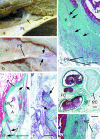The functional anatomy of the iliotibial band during flexion and extension of the knee: implications for understanding iliotibial band syndrome
- PMID: 16533314
- PMCID: PMC2100245
- DOI: 10.1111/j.1469-7580.2006.00531.x
The functional anatomy of the iliotibial band during flexion and extension of the knee: implications for understanding iliotibial band syndrome
Abstract
Iliotibial band (ITB) syndrome is a common overuse injury in runners and cyclists. It is regarded as a friction syndrome where the ITB rubs against (and 'rolls over') the lateral femoral epicondyle. Here, we re-evaluate the clinical anatomy of the region to challenge the view that the ITB moves antero-posteriorly over the epicondyle. Gross anatomical and microscopical studies were conducted on the distal portion of the ITB in 15 cadavers. This was complemented by magnetic resonance (MR) imaging of six asymptomatic volunteers and studies of two athletes with acute ITB syndrome. In all cadavers, the ITB was anchored to the distal femur by fibrous strands, associated with a layer of richly innervated and vascularized fat. In no cadaver, volunteer or patient was a bursa seen. The MR scans showed that the ITB was compressed against the epicondyle at 30 degrees of knee flexion as a consequence of tibial internal rotation, but moved laterally in extension. MR signal changes in the patients with ITB syndrome were present in the region occupied by fat, deep to the ITB. The ITB is prevented from rolling over the epicondyle by its femoral anchorage and because it is a part of the fascia lata. We suggest that it creates the illusion of movement, because of changing tension in its anterior and posterior fibres during knee flexion. Thus, on anatomical grounds, ITB overuse injuries may be more likely to be associated with fat compression beneath the tract, rather than with repetitive friction as the knee flexes and extends.
Figures







References
-
- Adkins SB3rd, Figler RA. Hip pain in athletes. Am Fam Phys. 2000;61:2109–2118. - PubMed
-
- Bas L, Oztek I, Numanoglu A. Subepineural hyperplastic Pacinian corpuscle: an unusual cause of digital pain. Plast Reconstr Surg. 1993;92:151–153. - PubMed
-
- Drogset JO, Rossvoll I, Grontvedt T. Surgical treatment of iliotibial band friction syndrome. A retrospective study of 45 patients. Scand J Med Sci Sports. 1999;9:296–298. - PubMed
-
- Ekman EF, Pope T, Martin DF, Curl WW. Magnetic resonance imaging of iliotibial band syndrome. Am J Sports Med. 1994;22:851–854. - PubMed
Publication types
MeSH terms
LinkOut - more resources
Full Text Sources
Medical

